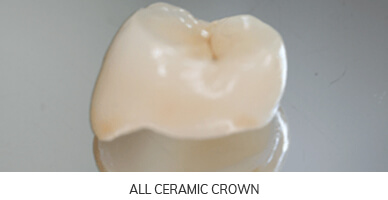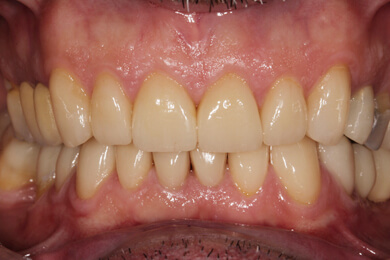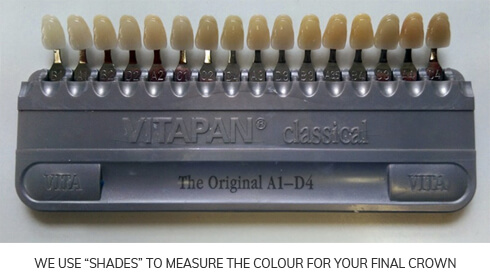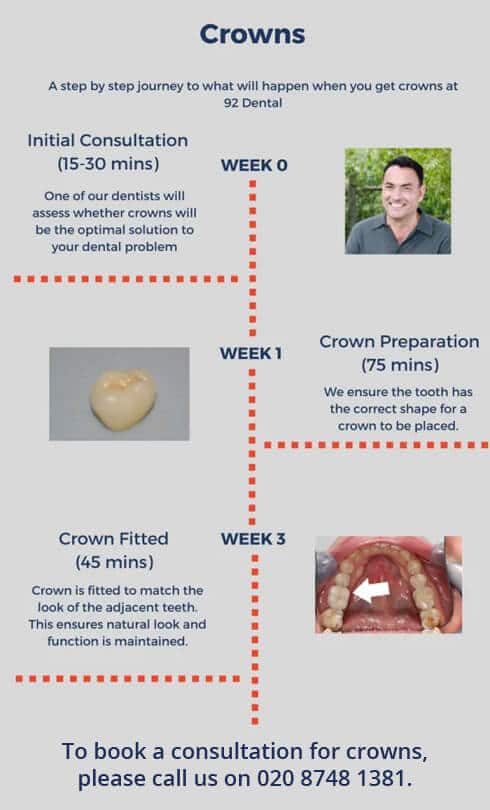What is a Dental Crown?
A tooth crown, also called a tooth ‘cap’, is a dental restoration that completely covers or surrounds a tooth or implant. Crowns are often needed when a large crack or cavity threatens the on-going health of a tooth or when a tooth has had a Root Canal Treatment. Dental crowns can also be used as part of a cosmetic treatment to improve the appearance of teeth.
Tooth crowns can be made from many materials including gold, metal-alloy, zirconia, porcelain or a combination of these materials. They are typically bonded to the tooth using specialised dental cements. The resulting crown is the colour and shape of the existing teeth and, if made well, will look and feel like a normal tooth. While inarguably beneficial to dental health when used appropriately, each situation should be assessed by the dentist.

Who needs a Crown?
A tooth may need to be crowned if there is a crack or a cavity in the tooth that is too large to be restored with a filling. Symptoms of having such damage to your tooth can include pain and sensitivity to hot or cold in the tooth itself. A large crack or hole in the tooth may also be visible.
In most instances, however, the type of damage that requires a crown to restore the problem can only be identified by a dentist during an examination. This is why it is important to have a dental check-up at least once every 12 months.
Crowns are also used to restore a tooth following Root Canal Treatment or to improve the cosmetic appearance of teeth.

TEETH THAT CAN HAVE THEIR APPEARANCE IMPROVED BY CROWNS

TEETH AFTER A COSMETIC TREATMENT USING CROWNS AND VENEERS
What happens when I have a tooth crowned at 92 Dental?
- The first of these, which we call the crown preparation, involves reshaping the tooth to the ideal shape so that a crown can be fitted in a way that preserves the tooth’s natural look and feel.
- During the crown preparation visit, we also take impressions of your reshaped tooth and fix a temporary crown. These temporary crowns are typically made out of acrylic and allow the tooth to maintain its look and function while the permanent crown is being constructed.
- The crown preparation procedure usually takes about one hour and fifteen minutes. Local anaesthetic is usually given in the gum that surrounds the to-be-reshaped tooth. The tooth is also cleaned thoroughly to ensure that no bacteria are present under the temporary crown.
- We use the innovative Medit i700 scanner to take digital scans of teeth and gums, rather than the traditional impression moulds. This digital process is quick and efficient, and eliminates the need to use plastic, rubber and plaster and saves on waste within our dental practice. As well as being a sustainable solution, using the Medit i700 also makes the process much more comfortable for our patients. Currently we use the Medit i700 for creating crowns, bridges and whitening trays.
- During this first procedure we also decide the colour of the permanent crown through talking about how you want the final tooth to look, and how the current surrounding teeth look. Ideally we want your final tooth to look natural in your mouth.

- We usually allow a minimum of one to two weeks for the dental technician to create the permanent crown from the impressions that we have supplied them. However, the temporary crown can last in the mouth for a lot longer than this. This allows for the permanent crown to be fitted onto the tooth at the patient’s convenience.
- Once the permanent crown has been constructed, we will need a second procedure to fix it to the tooth.
- Before we cement the permanent crown to the tooth, we will test the fit and allow you to examine how the crown looks in the mouth.
- If the new crown interferes with your bite, or does not look exactly how you want it to, the dentist can make appropriate adjustments. Only when the crown is exactly how you want it, we fix it to you tooth using specialist dental cement.This second procedure usually takes around 45 minutes and is the final part of your crown treatment.

